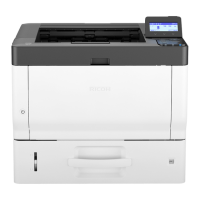Paper Thickness
*1
Paper weight
Plain Paper 2 75–90 g/m
2
(20–24 lb. Bond)
Middle Thick 91–105 g/m
2
(24–28 lb. Bond)
Thick Paper 1 106–130 g/m
2
(28-35 lb. Bond)
Thick Paper 2 131–162 g/m
2
(35 lb. Bond–90 lb. Index)
Thick Paper 3 163–256 g/m
2
(90 lb.Index-140 lb. Index)
*1
Print quality will decrease if the paper you are using is close to the minimum or maximum weight.
Change the paper weight setting to thinner or thicker.
• Certain types of paper, such as translucent paper or OHP transparencies, may produce noise
when delivered. This noise does not indicate a problem and print quality is unaffected.
• The paper capacity described in the tables above is an example. Actual paper capacity might be
lower, depending on the paper type.
• When loading paper, make sure the stack height does not exceed the limit mark of the paper tray.
• If multiple sheet feeding occurs, fan sheets thoroughly or load sheets one by one from the bypass
tray.
• Flatten out curled sheets before loading them.
• Depending on the paper sizes and types, the print speed may be slower than usual.
• When loading thick paper of 106–256 g/m
2
(28 lb. Bond–140 lb. Index), see page 86
"When Loading Thick Paper".
• When loading envelopes, see page 87 "When Loading Envelopes".
• When printing onto letterhead paper, the paper placing orientation is different depending on
which function you are using. For details, see "Loading Orientation-fixed Paper or Two-sided
Paper", For First-time Users.
• When you are using 45K copy and print paper, loading the paper fully up to load limit mark (MAX
mark) may cause paper jams. Load the number of sheets of paper described below, as a guide.
• Lower paper tray (500 sheets)
• A4 : 500 sheets or less
• B5 : 500 sheets or less
• A5 : 250 sheets or less
• We recommend that you use the bypass tray when you use a paper size smaller than the sizes
above.
• Lower paper tray (250 sheets)
Recommended Paper
85

